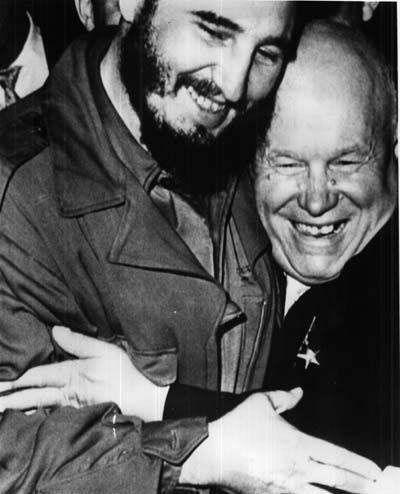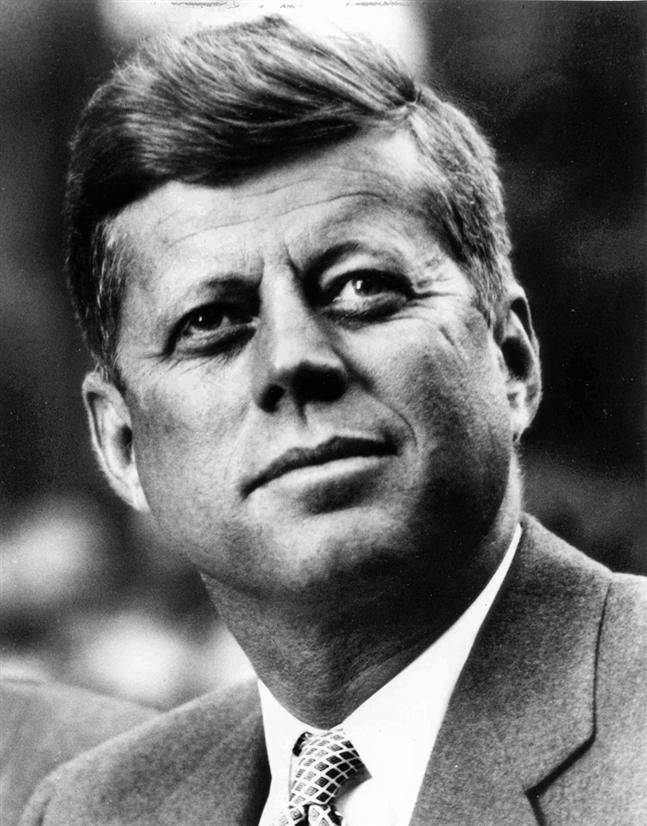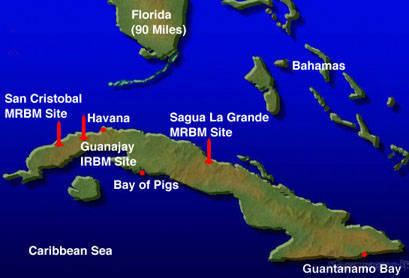Cuban adventure
We all worry about the future of our children.
And we are all mortal.
Df Kennedy

“Welcome to the family, compierno Castro!”
Once, in the circle of his associates, Nikita Khrushchev complained that the fraternal Communist Parties used the USSR as a financial "cash cow." They say that everyone demands and demands money, and then once - and they follow their own path of communism, like China or Yugoslavia. And about the "older brother" forget. Continuing with his own successful allegory, Nikita Sergeevich should have said that anyone who hinted that he was “illuminated by the great way”, this “cash cow” substituted his own “udder”. Not an exception, and Comandante Fidel Castro.
In 1960, rumors reached Moscow: the Cuban leader who had taken power a year earlier sympathized with the communist ideology. Khrushchev sent Anastas Mikoyan, who on his return happily said: “Yes, he is a revolutionary. Same as us. I felt like I was back in the days of our youth. ” As if to confirm what was said in December 1961, Castro officially declared to the whole world that he was going to build socialism in Cuba. Well, companero Fidel, welcome to the big Soviet family! It was not for nothing that, after Mikoyan’s trip, Khrushchev 9, June 1960, who was deeply moved, promised to protect his future brother at a meeting with Soviet teachers: “... if aggressive forces in the Pentagon dare to invade Cuba, Soviet gunners will support it with rocket fire.”
Since Fidel’s position in Cuba was rather precarious, the Kremlin decided to help with weapons (for $ 250 million) and Soviet military instructors in order to teach the “hot Cuban guys” to use it. By March 1962, Soviet ships delivered to the island 394 tank, 41 MIG-15 and MIG-19, 13 radar installations, etc. 300 Soviet military specialists worked. Cuban pilots were trained at military bases in the USSR and at a strictly classified training aerodrome near Havana.

Cuba will not surrender
From the moment DF Kennedy was elected to the presidency (November 1960), two major problems emerged in his foreign policy course - West Berlin and Cuba. Berlin’s divide between the FRG and the GDR supported by the Soviet Union has been going on for quite a long time, so the solution to this problem could be attributed to strategic goals. But Cuba was a communist thorn in the rear of the United States. Both his personal popularity and the rating of the democratic party as a whole depended on the skill with which the American president succeeds in pulling her out.
A trial balloon to overthrow Fidel by a landing force consisting of Cuban political émigrés was thrown by the United States in April 1961. The operation in the Bay of Pigs (at Playa Chiron) ended in complete failure. Soviet military experts have greatly helped the Cubans. Cooperation between Havana and Moscow has become even closer.

In 1962, the CIA and the Pentagon increased the pressure on Kennedy in order to knock out a sanction to occupy Cuba with the help of an American landing force. The president of the USA hesitated. In Moscow, where the KGB and the GRU received information through the channels of the foreign residency, they had an idea of the heated debates about the fate of Liberty Island, which boiled in the White House. However, Khrushchev was still inclined to believe that Kennedy would not dare to take radical measures, considering under whose fraternal wing Cuba is located.
A wake-up call for Khrushchev and Castro sounded in early April 1962, when the US Navy conducted major exercises in the Atlantic-Caribbean basin. Special attention of military analysts from Moscow attracted the landing of 10 thousands of marine paratroopers on the islands, the terrain and terrain of which were suspiciously similar to the natural conditions in Cuba. It seems that the Americans were preparing to implement their "Oplan 314".
Moscow's answer to such a grumble weapons not long in coming. 12 April, the politbureau 1962 decided to send additional military aid to the Cubans: X-NUMX air defense missiles CA-180, 2 IL-10 bombers, and also 28 military experts.
Nevertheless, Nikita Sergeevich was clearly aware that a trained American landing force would take only a few days to capture the island. The Kremlin could not afford to lose Cuba. Later, Khrushchev recalled: "It would greatly undermine our status throughout the world, and especially in Latin America." And only Mao, with their correct communisms, was waiting for such a blooper! ”
It required some weighty deterrent argument that would have frightened and stopped Kennedy. And Khrushchev chose weapons of mass destruction. The first secretary of the Central Committee began to use the “nuclear baton” as a means of political pressure as early as the end of the 50. True, in recent times, I had to calm down my ardor, because the malicious CIA found out that the USSR had had one or two ICBMs.
Khrushchev decided to send medium-range nuclear missiles to Cuba. “Let's let the hedgehog down Uncle Sam’s pants,” Nikita Sergeevich put it in the circle of his colleagues. Americans, of course, at first will be indignant, and then calm down. After all, the USSR “swallowed” the deployment of American missiles in Turkey at the end of the 50s! And already with nuclear weapons, located under the very noses of the United States, it will be possible to guarantee the safety of Castro, as well as put pressure on the young American president on the question of the status of West Berlin.
Khrushchev presented his plan to 24 on May 1962 of the year at a meeting of the defense council, which included representatives of the political bureau, secretaries of the Central Committee, and the top general of the Ministry of Defense. As the main reasons for the deployment of missiles, Khrushchev cited the following arguments:
1) The United States will soon attack Cuba. “It would be foolish to think that the inevitable second invasion of the United States would be just as badly planned as the first”;
2) “Aside from defending Cuba, our missiles equalize what the West likes to call“ balance of power. ” The Americans have surrounded our country with military bases and are threatening us with nuclear weapons, and now they will know what it is like when enemy missiles are aimed at you ... ”
Unexpectedly, Khrushchev’s proposal provoked heated discussions. A member of the politburo Mikoyan spoke most against it, insisting that the Americans notice missiles even when building launch pads. And then an inevitable military-political crisis will arise between the USSR and the USA. In response, the commander of the strategic missile forces Marshal Sergey Biryuzov promised to hide all the work under palm trees. “I saw these palm trees,” Mikoyan later recalled, “you cannot cover the rocket platform under them.”
Despite all the doubts, the Defense Council, as usual, unanimously voted for the deployment of nuclear weapons in Cuba, and also supported the deployment of the Soviet armed contingent to protect it.
"Chukchi motives"
The special operation was called "Anadyr." The Soviet contingent, led by General Issa Pliev, consisted of 50 thousand 874 people. Of the nuclear weapons, 36 medium-range missiles P-12 (length - 25 m, range - 1700 km, nuclear warhead charge - 1 megaton), long-range missiles P-14 (range - 3400 km), tactical nuclear missiles of the "Luna" type ". In addition, two tank battalions (equipped with new T-55), a squadron of fighter MIG-21, 42 bomber IL-28, 12 air defense missile units CA-2. The Soviet Navy planned to build a base for submarines in Cuba. To patrol the east coast of the United States, it was planned to send 12 submarines, seven of which had three P-13 nuclear missiles on board.
The transfer of such significant armed forces was masked by redeployment in the Arctic. The soldiers were provided with skis, felt boots, and fur boots. They delivered servicemen in complete secrecy to the six largest ports of the USSR from Sevastopol to Severomorsk. Here they were dressed in civilian clothes, and everyone got exactly the same shirt (this circumstance clearly betrayed the Soviet military in Cuba). Next was loading in the holds of ships. Throughout the voyage, soldiers were forbidden to climb on the deck. As an exception - sometimes at night. The decks themselves were forced by all kinds of farm supplies, giving the ships sailing to Cuba the look of simple cargo carriers.
About the ultimate goal of the movement did not even know the captains of the ships. Only when entering the waters of the Atlantic, having opened a special package, did they learn that they were going to Cuba. By the end of September, 1962, the island was about 42 thousands of soldiers, delivered almost all the planned weapons, including the P-12 and Luna missiles.
Pictures from Y-2: the beginning of the crisis
At the end of the summer of 1962, American intelligence recorded increased freight traffic between the USSR and Cuba. CIA agents noted on the island a significantly increased presence of the Soviet military, and also, more importantly, feverish construction in parts of the island closed from prying eyes. The American people, the military and the republican part of Congress were waiting for decisive action from the Democratic president.
The last straw that overcame Kennedy's patience was information from CIA head John McCone: aerial reconnaissance discovered eight completed CA-2 air defense missile sites on the island.
September 4 1962, Kennedy addressed the nation about Soviet weapons in Cuba. Ending the speech by addressing directly to Khrushchev, the president said: "The most serious problems will arise if evidence of the presence of Cuban Soviet military formations, Soviet military bases ... the presence of ground-to-ground offensive missiles, as well as other significant offensive potential, are found."
Moscow made two main conclusions. First, the US still does not know about nuclear missiles in Cuba. And this is good news. Secondly, Kennedy clearly made it clear that the Americans would not tolerate Soviet missiles near by taking the most stringent measures.
Despite the possibility of serious conflict, Nikita Sergeevich not only did not cancel Operation Anadyr, but also gave the order to additionally send six nuclear bombs for the IL-28 and 12 Luna-class nuclear missiles that the Indigirka delivered to October 4 to Cuba.
October 16 President Kennedy 1962 was introduced to the photographs taken during the next flight of the spy plane U-2 over the southwestern part of Cuba (Pinar del Rio province). The missiles depicted in the photo, Pentagon analysts identified as nuclear. The “Caribbean Crisis” has begun.
Who will win?
On 10 in the morning of October 16, 1962, the first meeting of the executive committee of the US National Security Council (Executive Committee) began. In addition to Kennedy, the Executive Committee included the first persons of the State Department, the Ministry of Defense, the CIA.
From the first hours of the meeting took a stormy character. Four main options for solving the “nuclear problem” were considered:
1) air strike on missile sites;
2) a global air strike on both sites and the Soviet aviation on the island;
3) American assault landing on Cuba;
4) sea blockade of the island in the hope of hindering the delivery of nuclear warheads.
For four days there were heated discussions. Kennedy was leaning alternately on the air strike option to the landing party and vice versa. Unknown "X" in making the right tactical decision were two main questions: are there already nuclear warheads on the island and what will be the reaction of the Soviets to the actions of the Americans? What if Khrushchev gave the order to respond with nuclear fire on the landing of the Americans? In addition, the 100% guarantee of the destruction of nuclear missiles during an air raid, the head of the Ministry of Defense Robert McNamara did not give.
October 20 The Kennedy Board decided to declare a naval blockade of Cuba under pressure. At the same time, the President, with the help of his brother Robert, the US Attorney General, began to make every effort to resolve the conflict peacefully.
Worried in the Kremlin. Through diplomatic channels Khrushchev already knew that the Yankees had discovered rockets. Jokes time is over. “The fact is,” Khrushchev said at the morning meeting of the October 22 Politburo, “that we don’t want to start a war. We want to intimidate, hold back forces against Cuba ... Tragic - they can attack, we will answer ... This may result in a big war. ”
Hastily, instructions were developed for General Pliev: in the event of an attack by the Americans, defend themselves with all types of weapons other than nuclear ones. By the way, in a truly Soviet manner, they also compiled the second option, allowing the use of Luna tactical missiles. The blessing was smart enough to stop on the first version.
October 22 1962 turned Kennedy to the American people in the evening: “The 30s taught us a clear lesson: aggressive aspirations that didn’t get a sharp rebuff ultimately lead to war ... We don’t intend to risk the world without nuclear war in which the fruits of victory will be ashes, but we have enough spirit to take such a risk when it becomes inevitable. " The United States "will view the launch of Soviet missiles from Cuba, sent to any country in the Western Hemisphere, as an attack by the Soviet Union on the United States, which will entail a response." Officially announced about the naval blockade of Cuba, which comes into force on the morning of October 24.
Throughout 24 — 26 of October, Kennedy and Khrushchev conducted secret correspondence in the hope of reaching consensus. Understanding that the missiles would still have to be removed, Nikita Sergeevich tried to get the maximum dividends: the safety of Cuba and the withdrawal of missiles from Turkey.
The peak of the "Caribbean crisis" fell on October 27 1962, when the Soviet U-2 was shot down by Soviet air defense systems, taking pictures of the island. The shelling was fired without Moscow’s sanction on the orders of the head of the Soviet air defense system in Cuba, Lieutenant General Andrei Grechko. Khrushchev went berserk, realizing that the Kremlin could not completely control its forces on the island. What if someone on a personal initiative launches a nuclear missile?
Downed U-2 significantly shaken Kennedy's “peacekeeping” positions on the Executive Committee. The President, realizing that he had one or two days left, made the last attempt. In the evening of October 27, Robert Kennedy conveyed the following conditions to the Soviet ambassador Dobrynin: the US president is ready to give guarantees to Cuba, as well as withdraw missiles from Turkey, but will not publicly state this.
October 28 at a meeting of the Politburo Khrushchev went to the "world": "... we were face to face with the danger of war and nuclear catastrophe ... To save the world, we must retreat."
On the same day, the order was given to discontinue Operation Anadyr. In a personal letter, Kennedy Khrushchev thanked him for his constructive cooperation and said that the Soviet government "issued an order to dismantle the weapons that you call offensive and to return it to the Soviet Union." Finally, the world was able to breathe easy ...
Information